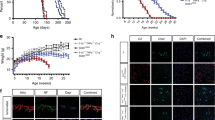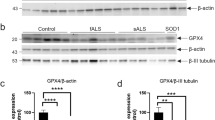Abstract
Dominant mutations in superoxide dismutase cause amyotrophic lateral sclerosis (ALS), an adult-onset neurodegenerative disease that is characterized by the loss of motor neurons. Using mice carrying a deletable mutant gene, diminished mutant expression in astrocytes did not affect onset, but delayed microglial activation and sharply slowed later disease progression. These findings demonstrate that mutant astrocytes are viable targets for therapies for slowing the progression of non–cell autonomous killing of motor neurons in ALS.
This is a preview of subscription content, access via your institution
Access options
Subscribe to this journal
Receive 12 print issues and online access
$209.00 per year
only $17.42 per issue
Buy this article
- Purchase on SpringerLink
- Instant access to full article PDF
Prices may be subject to local taxes which are calculated during checkout



Similar content being viewed by others
References
Pasinelli, P. & Brown, R.H. Nat. Rev. Neurosci. 7, 710–723 (2006).
Boillee, S., Vande Velde, C. & Cleveland, D.W. Neuron 52, 39–59 (2006).
Boillee, S. et al. Science 312, 1389–1392 (2006).
Clement, A.M. et al. Science 302, 113–117 (2003).
Beers, D.R. et al. Proc. Natl. Acad. Sci. USA 103, 16021–16026 (2006).
Di Giorgio, F.P., Carrasco, M.A., Siao, M.C., Maniatis, T. & Eggan, K. Nat. Neurosci. 10, 608–614 (2007).
Nagai, M. et al. Nat. Neurosci. 10, 615–622 (2007).
Bajenaru, M.L. et al. Mol. Cell. Biol. 22, 5100–5113 (2002).
Fraser, M.M. et al. Cancer Res. 64, 7773–7779 (2004).
Almer, G., Vukosavic, S., Romero, N. & Przedborski, S. J. Neurochem. 72, 2415–2425 (1999).
Martin, L.J. et al. J. Comp. Neurol. 500, 20–46 (2007).
Son, M., Fathallah-Shaykh, H.M. & Elliott, J.L. Ann. Neurol. 50, 273 (2001).
Barbeito, L.H. et al. Brain Res. Brain Res. Rev. 47, 263–274 (2004).
Howland, D.S. et al. Proc. Natl. Acad. Sci. USA 99, 1604–1609 (2002).
Vermeiren, C. et al. J. Neurochem. 96, 719–731 (2006).
Acknowledgements
This work was supported by a US National Institutes of Health grant (NS 27036) and a grant from the Packard ALS Center at Johns Hopkins (D.W.C.), as well as a Muscular Dystrophy Association developmental grant, the Uehara Memorial Foundation, the Nakabayashi Trust for ALS Research and a grant-in-aid for Scientific Research (19591021) and on Priority Area (19044048) from the Ministry of Education, Culture, Sports, Science and Technology of Japan (K.Y.). Salary support for D.W.C is provided by the Ludwig Institute for Cancer Research. S.B. is a recipient of a Fondation pour la Recherche Medical fellowship, an Institut National de la santé et de la Recherché Medicale fellowship and a Muscular Dystrophy Association developmental grant.
Author information
Authors and Affiliations
Contributions
K.Y., S.J.C., S.B., N.F.-T. and H.Y. conducted the experiments. D.H.G., R.T. and H.M. provided essential experimental tools and advice. K.Y., S.B., and D.W.C. were responsible for the overall design of the project, analyses of the results and writing the manuscript.
Corresponding authors
Supplementary information
Supplementary Text and Figures
Supplementary Figures 1–6, Results and Methods (PDF 5765 kb)
Rights and permissions
About this article
Cite this article
Yamanaka, K., Chun, S., Boillee, S. et al. Astrocytes as determinants of disease progression in inherited amyotrophic lateral sclerosis. Nat Neurosci 11, 251–253 (2008). https://doi.org/10.1038/nn2047
Received:
Accepted:
Published:
Issue Date:
DOI: https://doi.org/10.1038/nn2047
This article is cited by
-
Ferroptosis regulation through Nrf2 and implications for neurodegenerative diseases
Archives of Toxicology (2024)
-
FUS-ALS hiPSC-derived astrocytes impair human motor units through both gain-of-toxicity and loss-of-support mechanisms
Molecular Neurodegeneration (2023)
-
Safety and efficacy of first-in-man intrathecal injection of human astrocytes (AstroRx®) in ALS patients: phase I/IIa clinical trial results
Journal of Translational Medicine (2023)
-
The contribution of the peripheral immune system to neurodegeneration
Nature Neuroscience (2023)
-
Integrative transcriptomic analysis of the amyotrophic lateral sclerosis spinal cord implicates glial activation and suggests new risk genes
Nature Neuroscience (2023)



